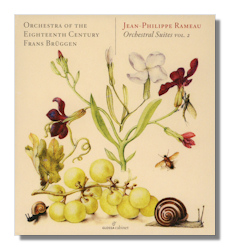
The Internet's Premier Classical Music Source
Related Links
- Rameau Reviews
- Latest Reviews
- More Reviews
-
By Composer
-
Collections
DVD & Blu-ray
Books
Concert Reviews
Articles/Interviews
Software
Audio
Search Amazon
Recommended Links
Site News
 CD Review
CD Review
Jean-Philippe Rameau

Orchestral Suites, Volume 2
- Suite from the Pastorale-héroîque "Zoroastre"
- Suite from the Tragédie en musique "Naïs"
Orchestra of the Eighteenth Century/Frans Brüggen
Glossa GCDC81106
The "rules" (not to say, the controversies) affecting the way in which words, music and action in eighteenth century opera were expected to relate to one another impinged greatly on Rameau's approach to the medium. He made use of the technique, Affektenlehre, which suggested ways in which musical motifs and praxes reinforced the emotions central to any one phase of an opera's theatrical development. In the two orchestral suites presented on this, the second volume in a series from Glossa featuring the Orchestra of the 18th Century with Frans Brüggen, conductor, though, Rameau goes far beyond such conventions to support his characters' psychologies. motives, fears, sadnesses and so on with motifs and musical sentences of his own.
Equally important for Rameau in the interests of providing stimulus, novelty (in the best sense of the word) and interest to his listeners was the unexpected. And we certainly experience that in the two suites here, that from the pastorale-héroîque, "Zoroastre" and from the tragédie en musique, "Naïs" (both date from around 1749). There is, firstly, a lively alternation of tempi in the 12 and 16 (respectively) movements; though without any sense of disorientation or variety for its own sake.
Rameau's instrumentation is particularly original with the use of a musette de cour (from the bagpipe family) in Naïs, tambourine, a variety of percussion and up to four bassoons. Even stranger, so strange in fact that they had to be hired from Germany in 1749, were two clarinets. Again, these are not for mere effect. But to convey the state of mind of his operas' protagonists. It's particularly noticeable that the musicians in the 40+ strong Orchestra of the 18th Century play both as individuals fully supporting this rich and changing palette of colors. And as a polished ensemble; a very polished one.
To this must be added noticeable changes in dynamic (the crescendo at the start of the overture to Zoroastre [tr.13], for example). This flamboyance (again in the most positive of senses) confers on the music a real sense both of intrigue, anticipation and excitement from first note to last; and a sense of finish. Both these qualities are needed successfully to maintain our attention – particularly when the aforementioned conventions, including those of Rameau himself, are likely to be unfamiliar to us. Brüggen ensures they're in constant good supply.
On the one hand, each movement seems to start with a new and fresh statement. On the other, it carries through the musical mood and structures in ways that indicate the presence of and adherence to a cohesive overall musical conception. These are not random, or randomly selected, excerpts or selections. In themselves, the movements of the Suites communicate the feeling, atmospheres and concerns of the (characters in the) operas from which they are taken.
These skillful evocations are all the more remarkable when the fact that the metaphysical theme of Zoroastre (the struggle between truth and falsehood) is so abstract. Add to this the requirement for dance episodes and the music (with some adventurous dissonances when you least expect them… outside cadences and resolutions) and the music will strike even listeners familiar with High Baroque music in general and Rameau in particular as splendid, enjoyable, beautiful, suggestive and moving.
Brüggen, through firm control and imagination, a thorough understanding of the idiom and what lifts this music out of the ordinary has produced two sets of suites that act as persuasive ambassadors for Rameau's music; and ought to make you want to explore the operas in which they originated.
Well-presented in a "Digipak" with helpful background notes on Rameau's compositional priorities and the works' (in the case of Zoroastre, somewhat lukewarm) reception, the recording is close, at times just a touch too dry, perhaps, and full of atmosphere – as though it were a distillation of just those innovations with which Rameau must have been so pleased and proud. This CD is not a sampler, nor a conventional set of Baroque suites. It's delightful, thrilling and highly enjoyable music which will satisfy many tastes. Rameau specialists both who do and do not already know the corresponding operas should not hesitate.
Copyright © 2011, Mark Sealey.





















